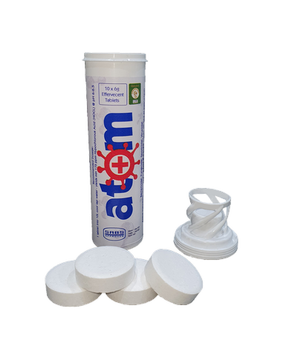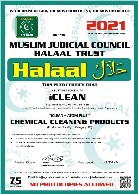Atom Plus - iClean
Main menu:
- COVID-19
-
Chemicals
- SABS Food Safe
- Laundry
- Car & Workshop
- House Keeping
- Disinfection
- Floor Care
- Brushware
- Paper Products
- Disposables
- Equipment
- About Us
- Contact Us
- Data Sheets
- On-Line Orders
What is HOCl ?
Quick Facts
HOCl is the scientific formula for hypochlorous acid, a weak acid which exist in the 3-
HOCl is made naturally by white blood cells in all mammals for healing and protection.
HOCl is a powerful oxidant that is effective against invading bacteria, fungi, spores and viruses.
Generating HOCl by running electricity through a solution of saltwater was discovered in 1970s.
HOCl is now used in healthcare, food safety, water treatment, and general sanitation.

How was HOCL was traditionally made?
History of Electrolysis
Michael Faraday founded the laws of electrolysis and it became commercially available in the 1870s.
Generating HOCl from the electro-
Early ECA technology used membranes to force saltwater into two solutions of HOCl and NaOH.
In the 1980s, single stream systems were developed that produced one solution of HOCl without byproduct.
In recent, single stream systems have been innovated to last longer and generate more stable solutions.
How do we make HOCl ?
1 x Atom Plus 6g tablet in 10 L tap water!
That's all. No expensive capital electrical equipment, no brine tanks and dangerous byproducts.
Atom Plus remains stable in tablet form for upto 5 years until ready to use, once dissolved will remain active for 7 days before it should be discarded.
The is no transportation of heavy and bulky product containers, no storage issues. Atom Plus is dispensed perfectly and accurately every time!
No. of tabs |
Water |
HOCl ppm |
1 |
10 |
175 |
2 |
25 |
140 |
1 |
5 |
350 |
1 |
1 |
1750 |
Hypochlorous Acid (HOCl) vs. Sodium Hypochlorite (Chlorine Bleach)
Why is HOCl more efficientat killing pathogens than other products?
Hypochlorite ion carries a negative electrical charge, while hypochlorous acid carries no electrical charge. The hypochlorous acid moves quickly, able to oxidize the bacteria in a matter of seconds, while the hypochlorite ion might take up to a half hour to do the same. Germ surfaces carry a negative electrical charge which results in a repulsion of the negatively charged hypochlorite ion to the area of the germ surfaces, making hypochlorite ion less effective at killing germs. The ratio of the two compounds is determined by the relative acidity (pH) of the water. Water treatment specialists can adjust the pH level to make hypochlorous acid more dominate, as it is more efficient at killing bacteria. The hypochlorous acid's lack of electrical charge allows it to more efficiently penetrate the protective barriers surrounding germs.
Food Safety
The majority of the research that has been done regarding the practical applications of hypochlorous acid has been in the field of food safety. Since the Food Safety Modernization Act (FSMA) was signed into law in 2011, the focus of food safety has shifted from responding to contamination to preventing it. There is probably no food sanitizer more researched and more understood than hypochlorous acid. The research clearly demonstrates that hypochlorous acid is safe and efficient for ensuring microbial counts are maintained below infectious levels on food and contact surfaces.
Surface Sanitation
Hypochlorous Acid vs. Quaternary Ammonium (Quats)
Hypochlorous acid has advantages over chemicals such as Quats when sanitizing food contact surfaces because Quats are not safe on food. Before cleaning with Quats, all food must be removed from the area before sanitation can take place. This is not required when using hypochlorous acid. Hypochlorous acid can be used continuously throughout the work day regardless of whether food is exposed.
Direct Food Sanitation
Hypochlorous Acid vs. Ozone
Hypochlorous acid has advantages over ozone. Ozone is a gas and is not stable in solution therefore it cannot be used to sanitize contact surfaces. Ozone is however used for food sanitation however it must continuously be regenerated as it is continuously leaving solution into the air. Being that ozone is an irritant to the lungs and respiratory tracts, ozone is limited in the concentrations that can be used, therefore limiting the oxidation potential that can be obtained for killing microbial pathogens. Hypochlorous acid is non-
Healthcare
Hypochlorous acid (HOCl) is already produced by the white blood cells in our blood for protecting against invading microbial pathogens. When microbial pathogens try to enter a wound, white blood cells are the first responders and engulf the bacteria exposing them to the biocide HOCl. Because HOCl is non-
Bacteria Inactivation
Chlorine is an extremely effective disinfectant for inactivating bacteria. A study conducted during the 1940s investigated the inactivation levels as a function of time for E. coli, Pseudomonas aeruginosa, Salmonella typhi, and Shigella dysenteriae (Butterfield et al., 1943). Study results indicated that HOCl is more effective than OCl-
This biggest challenge has been to create hypochlorous acid at a near neutral pH instead of chlorine gas or hypochlorite, and to do so in a stable form. Hypochlorous acid is a meta-
Disinfectants |
Log10 reduction |
|
| 1 min |
5 min |
|
Ethanol 75% |
1.83 |
2.00 |
Bleach 10% (10 000ppm) |
3.25 |
3.25 |
Formalin 10% |
1.25 |
1.25 |
Liquid Hand Soap |
2.00 |
2.25 |
Alcohol Hand Rub (WHO Formulation 1) |
2.17 |
2.25 |
HOCl Solution @ 130ppm |
2.30 |
3.75 |
Comparative results of various disinfectant solutions exposed to samples of SARS- |
||
SANS 51276 (EN1276)
Quantitive Suspension Test for the Evaluation of Bactericidal Activity of Chemical Disinfectants and Antiseptics
SANS 51650 (EN1650)
Quantitive Suspension Test for the Evaluation of Fungicidal Activity of Chemical Disinfectants and Antiseptics
SANS 53624 (EN13624)
Quantitive Suspension Test for the Evaluation of Fungicidal Activity of Chemical Disinfectants for Instruments used in Medical Areas
SANS 53704 (EN13704)
Quantitive Suspension Test for the Evaluation of Sporicidal Activity of Chemical Disinfectants used in Food, Industrial, Domestic and Institutional Areas
SANS 53610 (EN 13610)
Quantitative suspension test for the evaluation of virucidal activity against bacteriophages of chemical disinfectants used in food and industrial areas
Material Safety Data Sheet
Technical Data Sheet
Hypochlorous Acid -
J Oral Maxillofac Surg. 25 June 2020
Factors affecting stability and infectivity of SARS-
Chan K-
To KK-
Below links to research using Hypochlorous Acid in various fields
Summary of United States Regulation -
FDA Food Contact Notification 1811 -
Hypochlorous acid may may be used in processing facilities at up to 60 ppm for use in process water or ice which comes into contact with food as a spray, wash, rinse, dip, chiller water, and scalding water for whole or cut meat and poultry, including carcasses, parts, trim, and organs; in process water, ice, or brine used for washing, rinsing, or cooling of processed and pre-
FDA Guidance for Industry: Guide to Minimize Microbial Food Safety Hazards of Fresh-
The antimicrobial activity of a chlorine-
EPA: Food-
The following chemical substances when used as ingredients in an antimicrobial pesticide formulation may be applied to food-
USDA
Memorandum updates the status of electrolyzed water (hypochlorous acid) under the U.S. Department of Agriculture (USDA) organic regulations at 7 CFR Part 205
USDA FSIS Directive: Safe and Suitable Ingredients used in the Production of Meat, Poultry, and Egg Products
USDA National Organic Program -

Hypochlorous acid is cleared by the FDA for use on meat, poultry, fish & seafood, fruits & vegetables and shell eggs as a no-








